|
A Visit to South Chhattisgarh
Nandita De
Photo feature by Dilip Banerjee
Last month Dilip Banerjee set off on a revisit to South Chhattisgarh with a friend in an i10, driving 1200 kms from Raipur to Bastar, Dhantewada and other areas. The friend was from Bhilai and Dilip was there on work, on a specific project on tribals there.
But his focus suddenly shifted over the next few days. Suddenly exposed to an entire community of almost bare-bodied Adivasis, he saw up close an existence right in the heart of the nation which left little to human dignity.

Murgapandey village and its adjoining areas are languishing in public and official apathy. The tribals are innocent and uneducated and open to exploitation. While roads are being built and mining continues around the area, these people have somehow been left behind to their fate and nature. Forsaken by society. Forgotten by the state.
Driving through the area Dilip remembered the dense jungle cover he had seen earlier. The deep valleys. The flowing rivers. The Adivasi cultures. The tribal population in hundreds.
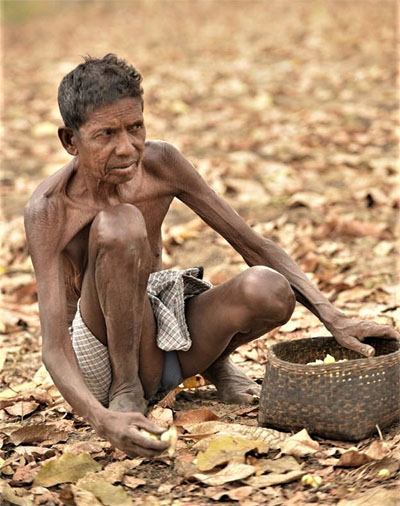
It was now April 2018. The forest cover had depleted in the areas he was travelling through. A lot had changed. The tribal population had dispersed quite a bit, migrated to different locales. The valleys did not look exactly the same.
The political climate was tense still. Ambushes and guerrilla warfare continued. The tribal population of course suffered the most. Caught in the crossfire, plagued by acute poverty, lost to the advances in time.
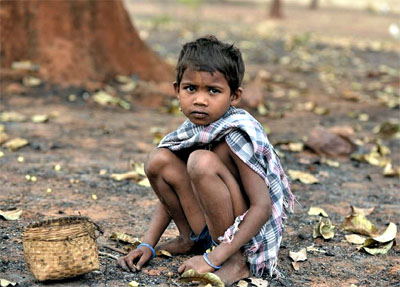
Neither knowing or experiencing 21st Century developments, they existed in a time trap. Moving did not necessarily mean adapting. Unknown to them, they lived in their rich natural resources state, in abject poverty, ignored by the rest of the country, the administration and the industries. Dilip Banerjee's photographic eyes did not miss the decay or the difference. The topography had been changing.
He was travelling down Dantewada district. This large district has seven tehsils. Surrounded on the north and north-east by Bastar, Malkangiri lay on the east. In the south and south-west was Khamman of Andhra Pradesh. River Indravati runs in the west.
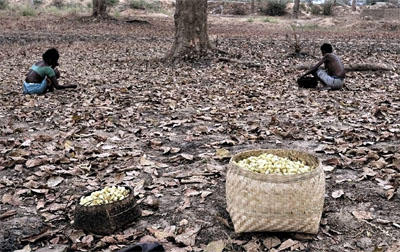
With 1094 listed villages and a primarily tribal populace, Dhantewada is a bustling district. Its Adivasi culture attracts anthropologists and environmentalists. But sadly, it is also very much a disturbed district. Deadly encounters are just recent news. Driving through, witnessing the current ambience with half-a-mind, Banerjee chanced on a village deep inside.
Murgapandey village is not listed. It cannot be located on a map. Possibly it lies unknown to most of civilisation. Caught in the tendrils of time, unable to extract itself. Ignored by the world, the people and the powers that be. Perhaps it's just one of many, who knows? Banerjee suddenly came across these tribals. Clad in next to nothing. To his amazement he realised that an entire village existed, where from child to adult clothing was almost non-existent. Young girls, older women had barely a cloth draped around them somehow. Children and men had loin cloths. This was not the highly protective Sentinelese or Jharwa tribes, fiercely rejecting civilised society. They were simply poor. So poor that they were still living in the hunter-gatherer periods of history.

The Murgapandey Adivasis existed as gatherers. They eat what they produced. Their occupation was primarily collecting mohua flowers. The forest cover was no longer so deep. The entire village collected the mohua and it was despatched to the rest of the district for distillation into liquor. The Adivasis of Chhattisgarh consume the liquor from child to adult without exception in leaf cups. This village was also engaged in the mohua liquor industry. Honey collection was their only other means of survival.
Few among them managed to save their modesty to an extent. Banerjee stayed and talked to them at length. Their ignorance of the world was an eye-opener. With meagre food, they barely existed. He realised in distress that when even young girls did not have clothing on them, what else could they possibly get in life. Banerjee's camera caught some pictures, but he was sensitive to their existence.
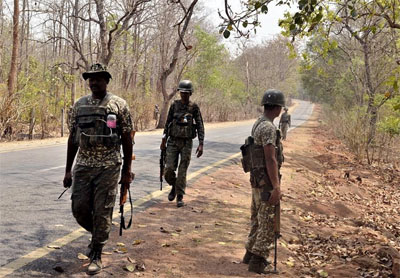
Theirs is a strangely equal society though. Women and children live without fear and intimidation. The gender ratio of the district is also perfectly balanced. Their innocence and acceptance are a lesson by itself.
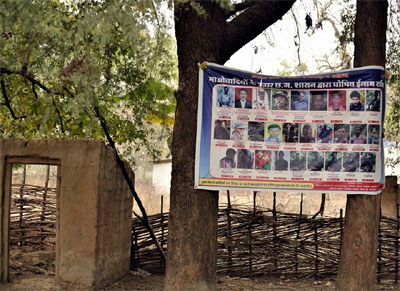
Driving away after spending three days there, on hearing of a personal emergency, he remains haunted by what he had come upon. The visions of bright young tribal women and children, allowed to wallow in their plight. Dire distress, a climate ranging from 22°C in January to a daytime temperature of 30°C - 46°C through summer. Heavy monsoons. Insect-infested forests. Bare-footed, bare-bodied. With posters of wanted Maoists with huge sums on their heads plastered in the area. Lack of beneficial social interaction. Lack of inclusive integration into society. Food, medicine, clothes, education, opportunity - almost non-existent. Living in a time warp. Right in the middle of a democratic nation.
Yes, in the summer of 2018.
Back to home-page
Frontier
Aug 6, 2019
Your Comment if any
|
